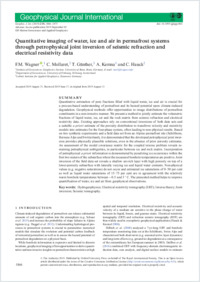Quantitative imaging of water, ice and air in permafrost systems through petrophysical joint inversion of seismic refraction and electrical resistivity data
- Wagner, Florian Institute of Geosciences, Geophysics Section, University of Bonn, Bonn, Germany
- Mollaret, Coline Department of Geosciences, University of Fribourg, Switzerland
- Günther, Thomas Leibniz Institute for Applied Geophysics, Hannover, Germany
- Kemna, Andreas Institute of Geosciences, Geophysics Section, University of Bonn, Bonn, Germany
-
01.12.2019
Published in:
- Geophysical Journal International. - 2019, vol. 219, no. 3, p. 1866–1875
Hydrogeophysics
Electrical resistivity tomography (ERT)
Inverse theory
Joint inversion
Seismic tomography
English
Quantitative estimation of pore fractions filled with liquid water, ice and air is crucial for a process-based understanding of permafrost and its hazard potential upon climate- induced degradation. Geophysical methods offer opportunities to image distributions of permafrost constituents in a non-invasive manner. We present a method to jointly estimate the volumetric fractions of liquid water, ice, air and the rock matrix from seismic refraction and electrical resistivity data. Existing approaches rely on conventional inversions of both data sets and a suitable a priori estimate of the porosity distribution to transform velocity and resistivity models into estimates for the four-phase system, often leading to non-physical results. Based on two synthetic experiments and a field data set from an Alpine permafrost site (Schilthorn, Bernese Alps and Switzerland), it is demonstrated that the developed petrophysical joint inversion provides physically plausible solutions, even in the absence of prior porosity estimates. An assessment of the model covariance matrix for the coupled inverse problem reveals remaining petrophysical ambiguities, in particular between ice and rock matrix. Incorporation of petrophysical a priori information is demonstrated by penalizing ice occurrence within the first two meters of the subsurface where the measured borehole temperatures are positive. Joint inversion of the field data set reveals a shallow air-rich layer with high porosity on top of a lower-porosity subsurface with laterally varying ice and liquid water contents. Non-physical values (e.g. negative saturations) do not occur and estimated ice saturations of 0–50 per cent as well as liquid water saturations of 15–75 per cent are in agreement with the relatively warm borehole temperatures between −0.5 and 3 ° C. The presented method helps to improve quantification of water, ice and air from geophysical observations.
- Faculty
- Faculté des sciences et de médecine
- Department
- Département de Géosciences
- Language
-
- English
- Classification
- Hydrology
- License
- License undefined
- Identifiers
-
- RERO DOC 327247
- DOI 10.1093/gji/ggz402
- Persistent URL
- https://folia.unifr.ch/unifr/documents/308077
Statistics
Document views: 115
File downloads:
- hau_qiw.pdf: 158
